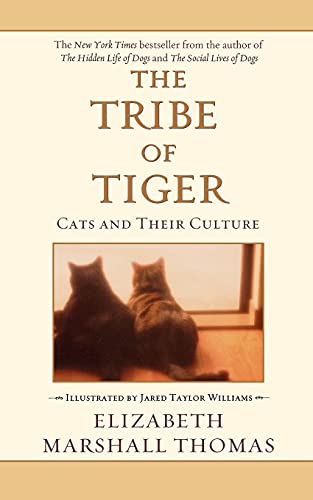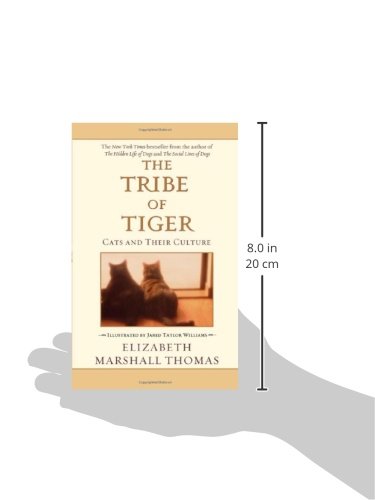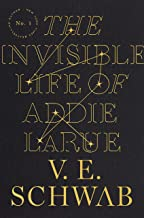The Tribe of Tiger Paperback – June 1, 2001 by Elizabeth Marshall Thomas
Paperback
[284 Pages]
PUB: June 01, 2001
Description
Author: Thomas Elizabeth Marshall
Brand: Gallery Books
Color: Cream
Edition: Reissue
Features:
- ISBN13: 9780743426893
- Condition: New
- Notes: BRAND NEW FROM PUBLISHER! 100% Satisfaction Guarantee. Tracking provided on most orders. Buy with Confidence! Millions of books sold!
Package Dimensions: 18x203x376
Number Of Pages: 288
Release Date: 01-06-2001
Details: Product Description
From the plains of Africa to her very own backyard, noted author and anthropologist Elizabeth Marshall Thomas explores the world of cats, both large and small in this classic bestseller. Inspired by her own feline’s instinct to hunt and supported by her studies abroad, Thomas examines the life actions, as well as the similarities and differences of these majestic creatures. Lions, tigers, pumas and housecats: Her observations shed light on their social lives, thought processes, eating habits, and communication techniques, and reveal how they survive and coexist with each other and with humans.
Review
The New York Review of Books Thomas enjoys the complexity and subltlety of feline society and rejects many of the over simplifications that have become “popular knowledge” concerning cats.
Booklist Insightful.
About the Author
Elizabeth Marshall Thomas is the bestselling author of numerous books, including
The Hidden Life of Dogs,
The Social Life of Dogs, and
The Harmless People.
Excerpt. © Reprinted by permission. All rights reserved.
Chapter One
The story of cats is a story of meat, and begins with the end of the dinosaurs. Before their mysterious disappearance, the dinosaurs had reached a sort of climax in the art of meat-eating, which had begun simply enough, almost with life itself, when the early swarms of small aquatic creatures had little else to eat except one another. For these early swimmers, plants as we know them were not an option, since plants had not evolved. As life became more complicated, hunting and meat-eating became more complicated too. Most of the vertebrates were meat-eaters — certainly most of the fish ate other fish, as did the first amphibians, who in turn became food for the emerging reptiles.
During Permian and Triassic times, predatory dinosaurs crowded out most of their meat-eating forebears, ending the long reign of the big carnivorous amphibians. From Jurassic times onward even the largest dinosaurs had predatory dinosaurs trying to kill them, with more dinosaurs waiting to scavenge the remains. The mammals had no chance to mount any kind of challenge. As a result, when after 130 million years of highly successful predation the dinosaurs vanished, they left behind a most unusual situation — a world newly free of carnivores of any appreciable size.
Even as recently as the Paleocene, sixty-five million years ago, only two groups of mammals could have been called carnivorous, and by today’s standards, or indeed by the former high standards of the predatory dinosaurs, neither of these would have seemed particularly adept at hunting. The first group, called the creodonts, were not built for speed and probably specialized in carrion, and the second group, called the miacids, ancestors of the modern carnivores, were for the most part very small and possibly specialized in insects; in other words, despite the new situation, both groups continued to eat what they had been eating when the dinosaurs were still around.
Thus, there was no one to molest the millions of large, hairy, milk-fed animals who soon evolved to roam the fertile forests left them by the dinosaurs, browsing the trees and bushes without much fear of predators. The early herbivores became a vast, slow-moving food supply which eventually even they themselves could not ignore. A few of them, including an enormous hoglike, bull-sized creature called
Andrewsarchus, gave up leaves for meat. The largest carnivorous mammal ever to have lived on land, this minotaur with a carnivorous habit probably lacked the delicate sensibilities of a true carnivore such as a dog or cat or weasel and surely must have been the most frightening predator the world has ever seen.
By all that is sensible, the creodonts should also have been developing themselves to better exploit the world of meat. Surprisingly, however, they went into decline. Their eventual extinction seems puzzling — not on
Be the first to review “The Tribe of Tiger Paperback – June 1, 2001 by Elizabeth Marshall Thomas”
You must be <a href="https://www.webdelico.com">logged in</a> to post a review.
































There are no reviews yet.